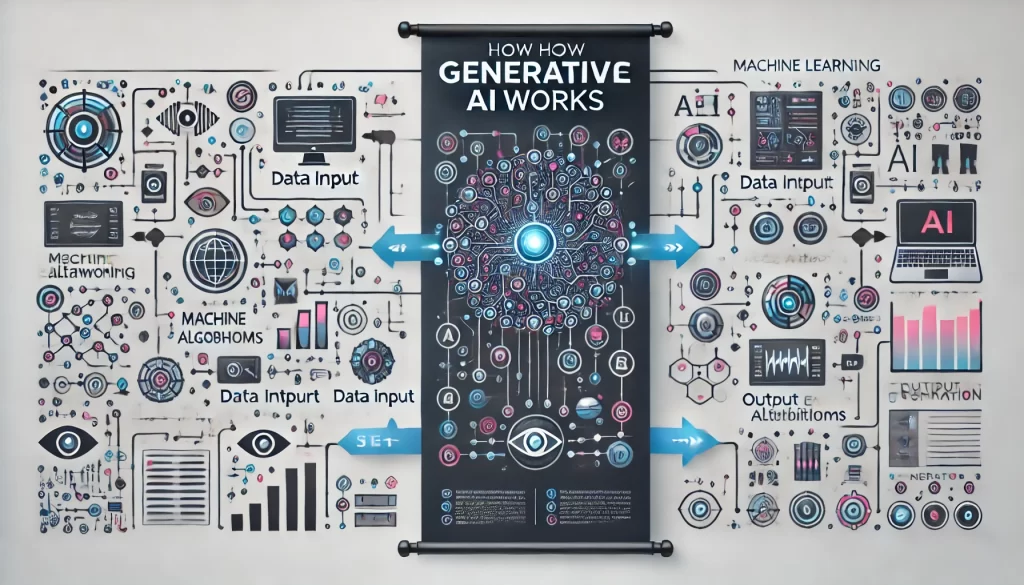
Generative AI works by leveraging machine learning models, particularly neural networks, to create new and realistic content based on patterns learned from vast amounts of data. At its core, it utilizes techniques like Generative Adversarial Networks (GANs) and transformers. GANs involve two neural networks—a generator, which creates content, and a discriminator, which evaluates it—working together to improve output quality iteratively. Transformers, commonly used in language models, allow AI to generate coherent text by understanding context and relationships in data. By analyzing existing examples, generative AI can produce various forms of content, including text, images, and audio, making it useful for applications ranging from chatbots to art generation. While generative AI has opened new avenues in creativity and efficiency, it also poses challenges, including ethical concerns around misuse and content quality control.
Training on Large Datasets
Training on large datasets is essential for developing powerful AI models, as it enables them to recognize complex patterns and improve accuracy in diverse tasks. With vast amounts of data, a model can learn the subtle variations and contextual nuances needed to generate high-quality outputs or make accurate predictions. Large datasets are particularly valuable for deep learning models, where layers of neural networks analyze different aspects of the data to extract and learn representations at varying levels of abstraction. However, training on large datasets requires substantial computational resources, such as high-performance GPUs, and can be time-intensive, often involving multiple stages of preprocessing and tuning. While challenging, this process allows AI to become more robust, generalize better, and handle real-world variability more effectively, enabling applications like natural language processing, image recognition, and generative AI to function with high reliability.
Deep Neural Networks and Architectures
The core technology behind generative AI is deep learning, specifically types of neural networks designed to generate new content:
- Transformers: Used in models like GPT and BERT, transformers are powerful architectures for understanding and generating text. They can generate coherent sentences, answer questions, and even write essays by predicting the next word in a sequence based on previous words.
- GANs (Generative Adversarial Networks): GANs are widely used for creating realistic images and videos. They work by pitting two neural networks against each other: a generator, which creates fake data, and a discriminator, which evaluates whether the data looks real. Through this adversarial training, the generator improves at producing increasingly realistic outputs.
- VAEs (Variational Autoencoders): VAEs are used for generating data that resembles the input data. They’re helpful for applications where data needs to have a continuous and interpretable latent space, such as generating smooth variations of images.
Learning Patterns Through Iterative Adjustments
Deep neural networks (DNNs) learn patterns by making iterative adjustments to their internal parameters during the training process. This process, often called backpropagation, involves repeatedly adjusting the weights and biases of neurons based on the model’s performance, aiming to reduce the difference between the predicted output and the actual target. Each time the model processes an input, it makes a prediction, and if there is an error, the network calculates how much each neuron’s weight contributed to this error.
Using gradient descent, the model then updates these weights in small steps, moving toward a more accurate prediction with each iteration. By continuously repeating this process across many examples in the training dataset, DNNs can fine-tune their understanding of data patterns. These iterative adjustments allow the network to capture intricate relationships, learn from errors, and generalize knowledge, ultimately enabling DNNs to make accurate predictions or generate high-quality content.
Generating New Content
Once trained, generative models can create new outputs based on prompts or seed data:
- Text Generation: A language model like GPT takes a text prompt and predicts a sequence of words based on the learned patterns.
- Image Generation: An image generation model like DALL-E can take text descriptions and generate images that visually interpret the prompt, drawing on its training data.
- Audio or Music Generation: Generative audio models can create new pieces of music or human-like speech by generating audio waveforms that match the input prompt or context.
Fine-Tuning and Transfer Learning
Fine-tuning and transfer learning are powerful techniques in machine learning, enabling models to adapt to new tasks efficiently. Transfer learning involves taking a pre-trained model, which has already learned general features from a large dataset, and applying it to a different but related task. This approach allows for faster training and often achieves better performance with less data, as the model already understands foundational patterns. Fine-tuning is the process of further training this pre-trained model on a specific, smaller dataset that’s closely related to the new task. During fine-tuning, the model’s parameters are adjusted slightly to optimize its performance for the new context. Together, these techniques save time and resources, making them particularly valuable in fields like natural language processing and computer vision, where large datasets and complex models are common. By leveraging knowledge from related tasks, fine-tuning and transfer learning boost accuracy and adaptability, especially when labeled data is limited.
Handling Challenges and Biases
Generative AI models can inadvertently learn biases present in their training data, which can impact the accuracy and ethics of generated content. Developers work to reduce these biases by curating balanced datasets and implementing control mechanisms, but challenges persist.
Output Evaluation and Iterative Improvement
Generative AI outputs are evaluated and adjusted to refine the model’s ability. Some models use reinforcement learning from human feedback, where human reviewers rate the quality of outputs to guide improvements.
